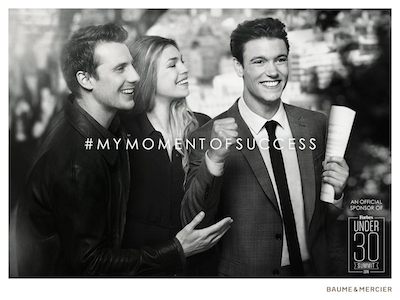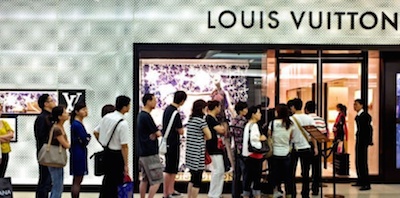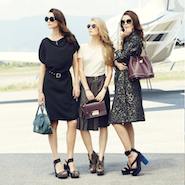As the luxury landscape continues to evolve and geopolitical turmoil affects emerging markets, the brands that will come out on top must be able to adapt to the resulting consumer behavior.
On Sept. 29 in New York, part of a 15-city world tour of sorts, Albatross Global Solutions shared insights from its annual research study “The Journey of the Luxury Consumer” to better understand motivators, the purchase journey and the consumer landscape on a global scale. A key finding has been the definition of luxury itself as consumer interest has developed from a desire for exclusivity to wanting ensured craftsmanship from the high-end brands they interact with.
“Consumers interact with luxury brands through a number of touchpoints,” said Javier Calvar, COO at Albatross Global Solutions, Shanghai. “While the boutique is still key – and will remain so for the foreseeable future – digital platforms such as branded Web sites, social media and applications are critical to brand building. Brands must therefore pursue a multi-touchpoint strategy.
“A high proportion of affluent consumers follow luxury brands online and are open to be contacted by the brands they buy,” he said. “Luxury brand owners must therefore go beyond transactions and maintain ongoing, meaningful conversations with consumers. This requires the development of relevant CRM programs.”
Aiming to understand the luxury consumer better, Albatross surveyed 4,180 affluents in 15 countries, adding India and South Korea for the 2015 edition. Individuals surveyed had purchased a luxury item within the last six months to ensure an up-to-date frame of reference for experiences had with a luxury label.
Motivated millennials
The 2015 Journey of the Luxury Consumer narrowed its lens on the millennial and the Chinese tourist, two hot topics that luxury brands have spent ample time trying to understand fully.
Overall, both consumer sects place an emphasis on craftsmanship, feeling that this is the true essence of luxury and that a handmade product of high-quality justifies the price point, thus adding more value to the overall purchase. In the past, exclusivity reigned, but now consumers find this overused, erosive and tired because if everything is “exclusive,” than nothing truly is.
Millennial respondents are an example of the transmission from exclusive luxury goods being preferred to craftsmanship being a determining factor for a high priced purchase. This sentiment is held because millennial consumers see the value in making a purchase that can be passed down and are hyper aware of details, both in terms of product and the overall brand experience.
In addition, a key motivator is often a purchase for an accomplishment such as landing a dream job. Thirty-eight percent of millennial respondents purchase luxury goods as an inner reward as a way to underscore social success and acceptance, in addition to using the product as a status symbol.
For instance, watchmaker Baume & Mercier played into this with its #MyMomentsOfSuccess campaign by sharing consumers’ moments of success through a new social initiative meant to highlight the brand’s timepieces as part of an achievement.

Baume & Mercier's #MyMomentsOfSuccess campaign
Baume & Mercier often features moments of celebration in its campaigns to connect consumer milestones to its products, whether the occasion is a promotion, graduation or wedding. For this campaign, Richemont-owned Baume & Mercier focused its lens on millennials who are “young and ambitious” (see story).
The survey also determined millennials’ interactions with brands in the digital space, with 51 percent of the demographic feeling comfortable with shopping online for luxury goods. This is compared to 44 percent of consumers globally and 48 percent in the United States.
Millennials are also more inclined to follow favored luxury brands on social media, with 59 percent responding that they do to find out about branded events, new products and promotions as well as connect with like-minded consumers. Additionally, 82 percent of millennials actively “like” brand posts and prefer social media and online bloggers better than traditional print.
“Millennials are the largest demographic group and affluent millennials have the means to make their dreams a reality,” Mr. Calvar said. “They are also particularly pro-active consumers, engaging with brands and sharing their views with peers, primarily online. Luxury brands must therefore embrace these younger consumers.”
China rising
The Journey of the Luxury Consumer 2015 survey also delved deeply into the behavior of the Chinese tourist. Of the 180 Chinese tourists surveyed for the report, respondents had made luxury purchases with an average price of $25,000 to $50,000 .
It is well known that Chinese consumers prefer to shop outside of their home country for a host of reasons. Ninety-two percent of respondents said their reason to leave China to buy luxury goods is due to cheaper pricing, 57 percent to ensure authenticity and 47 percent for product selection and souvenir purchases.
These points have driven Chinese consumption of luxury goods while abroad, especially product selection and items bought as souvenirs, as this plays into consumer storytelling and is much more impactful when purchased on a trip.
Overall, 90 percent of Chinese respondents have an interest in luxury items unavailable in China, and 50 percent have made an unplanned purchase while traveling based on availability at home.
Since Chinese travelers spent $165 million while abroad in 2014, and are projected to spend $274 million in 2019, an amount close to the GDP of Singapore, brands should amplify product offerings abroad to attract this demographic.
Albatross’ “Chinese Travelers and the Luxury Shopping Experience” survey found that 50 percent of respondents said that better product selection drives their choice for wanting to travel.

Chinese consumers outside a Louis Vuitton boutique
Importantly, more than half said that they expect a luxury brand abroad to have inventory that is not found in China and nearly all respondents said they were interested in buying new brands not sold in China at all, regardless of the retail push put forth by many to have a presence in the country (see story).
A strategy suggested to meet this interest is a type of click and collect program, popularized by retailers such as Selfridges in the United Kingdom for the purchase of luxury items such as Cartier jewelry (see story).
The program would allow Chinese consumers to showroom products available abroad while still at home as they plan their purchases. Then, when they reach their destination, they can collect their purchase seamlessly at a brand’s bricks-and-mortar location, which may also spur impulse buys.
Understanding the behavior of tomorrow’s primary consumer demographics will help brands transition and navigate the luxury market going forward.
"Millennials are not too different from general luxury consumers in the sense that they share the same cues to luxury and follow very much the same journey,” Mr. Calvar said. “They are however much more reliant on digital word of mouth than other consumers and listen to opinion leaders on places like Instagram, Twitter or WeChat more than other consumer constituencies.
“On the other hand, Chinese tourists have very distinctive traits, such as the way they plan their purchases. They actually draw a list of the items they want to buy, and the reasons why they buy overseas, which include the expectation of an authentic experience and choice,” he said.
Final Take
Jen King, lead reporter on Luxury Daily, New York
{"ct":"dHkERICdIbA+PinvclM+TttHIfqDd44tBMK64\/i+A7PM1M9TSvpsLtoY2OLuwxWmwNLOwADn5HNymSeHNScB9k9qTEUx2qVosYFDp1ikvURTCcfTNJ5ylGtlIZoLOS21gwlXFfErOq\/llBc6kCiJXspcPNrcAiphWydFSg7p74BsaMnoiA6Bvps8zKbP9EtpMyPzjZGDQeD1pLC5\/DcQ+qYMYVncPvlJQV1EzlCdsNE5vFR00HwrkNA9TElZmMwQEpLd9s0qmUa5\/g7idt0K\/mbV1kIi+MXYWMMkR0GL1MUK8JWElttNmAxItb4cQQ170AqRabcTh1VeapWaVXIsm+6rF2sJ6ryR+J+zQ+bBTFpa4WPuihzzoSVx66oaEnu6UXX0sfGbgSaULS87bK1Y+qmH76z53YbG9LPIRBmHnc7qH996BYcHUG0SshdiMUqTloLbmwZBc\/arhj6AsFaY9orvgSETNP\/8ea3EmT\/OVucMzxkY7kRjjx2QmxqPwWkZn0b3\/wrhndXwGmhoT6W5hmxoDvHoEIu2ehFcUVVMUDEeoQM4raOOnUD8y\/5ocgxwXoKt5ncE6WltCH62PuO1AMhIqtrsUma0BepfggcO5WvXkEhU6Pgk5XdobZ1Kb4R6X7muJX0E\/2XaMQq31NrlHhurOjDSQuzOqRj9NpqYgZfEMYrdUa0skd0sjilPxncEycehDiXEwrUOEEKSxbfeUTMmyajTvaU07tkqsN8N\/M8dCBrFT6KgcPsbc\/ULiVoQLd77LekcDlssiM3F4dEBeMzEofPrZ6isNxL4j5kxVL74\/Kl\/fO\/Uq9vQPZ7NyLAAYESrYhO\/290JAghYxGf\/oHZlEuCHN4jRvXb3Ye4QSSOJwwGl4ijOn6qVd0ir3XLL0UEtf2VJUrjRYJHf37ifk6ciTQVpQm7U0f4TENm9n5\/hmHHeN7mZFPmD6z\/bpqbbunSfSmrMR9POYwVtRGzH6amZw\/k+Gsrh03S0ghUrWYmOXKsS+djhtrr\/G1Jhb9t5zS5yW\/718cNE9iTCQyOIdtfEjMgSBXibeXobgBZZXg3CfuWSHLfEEIRhty5UiBAEGWglEfWFeDOyMtocz4mBNQilvwmYl+v85E1gkSc5CoQvFzJRfL6ILR6KP8yt3rNrutfK9kz6aCZyAvOaK+1XTywTvk3H4h4GHKJQ77ohI+eAESZdouyyuTtIsbpQu2wSigy9yUmBoqoLd27sEHlNE0SxbOALFX9ebyTQFhES0kcAX7J700NgrIdKz1Eu8Af+19Nrbra64vESO9RWhe29Bab1pzmDiSl\/ffZ+fX34EBfes+iewx3rZ3hHExTvcb19xOIaxuia3vAcDHVOdvmf9Evl5tpn9YU\/68If0QmIVWHpwk68jXGTJEqzM6kM9rKH+yXRZTUxGS8MCbTAFaGx6L4nAdqufWkKFLnsU6S52I15MCnir0JZebd3kXY88eSt7QdTFkYjqdYxnl+UJDK6OWJ+miIpFLN8miXgXzQwaiU3vMnGf0y2SUk8kM6I+r8rs+6nU7FoRgX7VGWLVKGDM9ettOaiw9hoBrKoPBQ\/sIfeknzZtc0sDFXhPxr7WeTfNR+hCK\/E39ZSzVNQuA8enzy3CpXWgEBbQKdsWHzHR7kpS0yXGI5i7sueW14\/FQcy\/DWLQJtgjpwYEoYGPCQ2J5dZskBgN8bu\/SGDQMSPCsl4dJq0ufghU5\/KxxjLnhasRc0Dssi3Mi4feoDv2erIr5\/Zs\/q99gXdZzYlyqpOHqPLwHYeL\/R\/ept727Ux+dWkBqclLdG6GzWQIAIeJLJpMV850l7AgqT0QE8t\/gTAxl7F4tnNFYDaQYB0ZBVqo1I5kDXC7n0zm+trrYeWejs83Bupk2ddhFEaPAmS49GSslxty8NwdU5Akz47IFFy0bNVJkC5pfjIe29DxezoqY0fPgaJmJcTQFV9veKZZb45lfnFDl8vfVZn\/dlPh\/159DXOBhhAnCtCG86CMP7ifBpud6tW+FFlvxccpoiH8dXHG\/CaIEEgjPIJwlImE5n4XiFzjGY0kPbzMkF1oK+\/vcXx\/H+BupP+HxY7fa5JvtZ9J2Ym8eho48X47c3lNe5BiesW\/NohNLaaMdXbOxeBEGCW\/Q6CPEf3vzVKE\/sIOD5X3UdQzQIXpoSF7qzuIyteojfkZ5WbU1hiBwJ8BcvmqQ\/xkoo1Du4tMEKq3XTzcEIRSM02aPw7FqIqSFmqzANM0v9dUzRNhl87VdO9zRiwFcl5z2X6kiD+uNHHnth6ExTjdIOTmBaJY4F3u6oAl7fJckZCPdYu7NvuNlb7opXmDebjrHtsueearNK\/qASUzgNni3gnKaL5BXtDsOBu3BrEz5cSXqWxntNTkKQ9Pb0BiKeRP0N3OEFAGJ3KQhZ2Cifc8cQ8U+Jlh\/Fl4qEzuP4In0gIXduwnR6HZT6c2fLxpzX\/RgauQp\/XBVnnlndTNlwk\/ObSBtUXkWIR1gO0OT6U7BJM68oaUBr\/LW\/BHPH\/+AvMk\/qbwVZqHRNexnVOByVAooeQNW6GfkeOrqUSKKzHDCSpIWsIOzHloYvZA1Ghr85yAg8K3qdP8hEvn4Fi9HpgbOYMfE\/hqqF0ekl6SHjFFWumc2qpiwZfEUHc\/fHGcEwWgzcAr+L77gWx04CS4iy9Z1+do6hjO4X0oYOmPXW6P8r1BUDeLiWvPiZtCVr9V\/eXOdS2W5IaslF9Z68DVQPBvFPe\/GDWPbHjSk6pkepf3Xodz3tgOSsg\/czjsJOxFLueyuSOT+sxztukto+SpPHVhzYDgjhGu1hXfjk\/BH\/VLO5f5HdS1tFcLEAhq337r9O0z\/7vyL+7JWl5kdCMDDPa+FiKH8OSTeoGVJ1mIZqQIiSNBgftkykzwzcT3EOTsuepNRsoezae8Bx7J9gLseU1z0vskmkqLcF7Ytzn8HkZxLSa7PvzXwYpEZhmdp1A840lkAsGXdDOTpz+U2qsjRCS4GF9WscTxi+xRG9LC+9mtQO0denM8J4K3xMMc6ONgqbSmYlRa7wsGHWMQnxFWaqr2ibJSmNIxsdSK0GPHO4dyb603lb3ykuTZclk7K8CqJ\/KwPT4JQbziYmD2nJzEzu\/X9NpxGVWuNlz65DFleNZ9ZxvjYR\/Q6NkFD4COWJJWCxY5J39Gmsp02KHWfQBSoCY1VvC6AcVrR+Xgcvje6K7hhFPZTTnDTl9cRzr1Yqm4FvJINXIVhvq\/mKLCmw\/7kJ4mEUGwuNl1e8vtALm+IZcnm7Yi6hxzs\/kUEC\/hHpTFxiG6UeWpns7YPWcIcvIc3ojmPFDx6mOHWMic955mPcHO63AdK3Lis4DVuDalU22K+lwSz1c1LZ8VZ2wMRdwc5Jc7i4Q0EjroPuhN6wONf4gHR6k9RJSljx4sHYqdEKlFexDcR9MPrwWXEtDAuyg9JGNJqqwtiGIU5O\/kxIxKJ0hfuFyDNZ1OS7wSJuaxjXjC8SHvw6yUy81w+pxqGpmk3qnrtShrl36ONAIMO9AN6dshi9JBb7sLoVzqu+3oykjqtaDdJj1febkdprLtRb3MVl+VQF0eLwr0OEySnG26z\/+3spRAuI64RM8z1lrmaqdpzcKgQ6CUBOgvnZSrxnIeI0hqJ7oS82ekP8\/QtV1segiEg9PIlQCMrKSjECTkqPFZi08tLC4sT3ctnbjyGZ7YBL1A76ag2hRCKB4y9jNR8cPQApJQ0ug1X7aRb8X6tJ\/hhNsErVSjSOZBDWCZl1vabAo82QgCulI0Bhy1w5ulnpeQDq\/18WFh3p6bCmd8WdpOPcgl96UJWSv0vfpZt2EeHNO4jvbS4OUnoZA7dV24ZiZRhlXSHojzt7kSrndtgadqTX3vytZTKX99Y4IPvDye\/p6mk2Y9zK2yjjwrWp47K7kTIY\/lOeWDJ4QrlzeSVmYV8XNN3ttiZiFyAPwtnDgNabanPH0oAja61XSJoThfycE73r5z9XeCCWSNDgzcJLfyJfg8dwkL4cxO4DuWiQB1JNu2cEHdmxWMMwpBX\/1vrKy78JSJOxVvb4IHwRLyGAFFg60C7GY0hNUs\/Uwb+2w+cGU7GXiVJ6CyDO0CSP\/IDCfMoG+EDiSoAmqi6nh7FAyIZeUp3kq+qUnLnfOGkeH+sJecuR1hmzqkxAB+kFrsRqMuaDI5eVB\/2BUIL+Sz4qr2drCqC9zSZaU3rS\/+\/XsZWSHBFEQ6Hlfhfrq5zEgvVQQwja3xaTNEmwsZCYV7BUrzUW1tnOIu5VUFMLywWr2WDajGBgQDpJjjWoVVXN9fNyud2HXhqaUAlCiWRPsHRZk\/dmWraUQBZDz29avFZoBwwtDKEY+Oi3wt8fjFhqi0JEjhjgLIghe\/TWyrG5M9yMTIVQlH0t1RM3eYqtxqs6fHzZp\/9JBQQWBmnNmzd2d6deXJqZqx1vCWliQXstx\/lRA1pT0tLCcWPP6Jd1PQf\/8F1aRyImKYO8\/iGUIlu\/7w9XbKzoaN+B7WVo2M5Crrr6J4CMTRWfn8e\/eUholzJExEEyGh2r5VotyoqlCwW0YTN7znO5oqgA+RJdNRs80VUZZkD9w+Cv80NyANeT9jKE6PiYK3lqXxxGCILSMwDI8FiZqBe6L\/5tnS1eHNwLzVjMi656rubuuiwp9Qk3XS6vUg9y4LJ26bO\/RMR0Hm+CL56ADC9M\/AQ\/LAp7BB5smyoOSUdppUxxP4+9hvJ4MvIWXsxeBA6zR9iCqGyBrivQQBvH57CH5o\/QwUYYVHcRuCp1t6+JhpRQall1CYx8ieNTVExNi1Br3kBdgEUqsFO8j80fkiNfkeQcDwkQPhI3q3rl7TpGwwDjRRSOrHoN9Ose4oGIavsYpeztsUweA4ZuzzLKSwx\/Y0AMd0Jyh8P1dCDduOWgBQpLV\/LKVSGiELeh8eV13dVOa595dN8SsGB0tUqU9NZfYIXCD3hHvqUlJ1PuoB\/ywTu4U57IbKHEV+XuVeubclll8htWZ02jboeNvzA1MbNxcHslduePUITTFSYSf+xbfxhscC8ofA2SYF2+v2pngQ4NBXuHrQ3juc0inNdKnK\/7A9gn3zR3tQlQbWTpOAOWy1+ltwOhdeDD2DIS14IMI5PsGGOhMJSvzaEzLgdOQlEhwKygVqY\/qePEeA+J+F9RJKBnFtlTNA48rtWZAIKj+V6tNKNGZbUfMzbgIxUYnzYeazGU7hbecBLohMa71HFIwdeqZS1WWABwB1GTCv2WTP\/jmkgBOKMJf2LZ5Qjf0JCvSeFsKW7CBceCmlMdmV9S103vR4fk9WHxWpFXvKjZNxZ9qJEs2ANbUb9fsQCzSXxToMQkWD8BDokJEzgn10JcVXi9o+dYN9312hwAcNPpJRwNEEmZEq+6efZdHtkSg3du+wvf4qPU1NzhZwCWZcodLvCDUxq1iwAPGlO9itd0omVwoAWQfFQRA57GiUyqsmWHSV9jvF3ULacvipZeVR9OSHFXmKA8\/jtkTmFP8VwEx7MdINwQ2IepJtkUHD7hjL5Ty04cbFuh7+AFSv+LcJxNI3RfQUdcM0AWTUkfm87gW6VnO\/gRKLP4W6K7mN4jwY5+JGDIuPuW\/Wp4BjHxPKhnALUn7miBWhVzaLNHu7Mlqr3+8tndW5\/D7IlJeqvkUDY4Hg9XfQYVZnyy9PKgWb+0K3zQYPMuGZ+SHbey1u7N7EA0s0yhz8bzG7t0Z53CVTKMN3djt5WJEu5nA1jMp2bms85b6qXWAOdsbC5TA0+mu6IsLd2yGdm5SR5wpYG4rBpbFsVBhAhmcVi\/bQ32JtmvL6f9W9+dY4Z6wVDFZ89dusQPeJS18670BFJfvK7GRX9GESRdqtJe+ClMxk5tzGwEr4JzCmTRmY4OiguxOlnIPCviOBnB5uZU1sCsHGb1FEPxvSPaYpdbTNnsgsXRqxytT5\/r7gAcmOfSch+s7tbs\/oBOpbDZUi4PVkYTjiWGIVOY3ooxEdhtMiCxNk3PG8YdMWXiPM\/hr3oW9WOKastjwNo4JF9JLy3wZ3i1PVhApRoHGjokYBdNdmNs8cZxnDuP\/PeYGl8axipzC5HPN5chO6roSOC1WJVbZL7312xh6zpljMcAUcK+wmlBQFHbWf+YAX2J6rmwUN7kSh4pMxxoXVkqZ\/\/pA8ia7FlPDPdzpulQS7aNb8B1VUcr9uuqFbA1bfCfOs7+hLs6SHWtQvo64sY8j8Ta6p6A59Q5HY2iD+8V5PjxP80ZIyR6ZCUA\/4fpl46TyHJq2SWphPQsvdpX4DRKPAOlYPVJZkutIeEqTJ2xTEgla6qgN+ZxvKz5mv+5UPWQ6Uqec79zVBqQYwlN9hT4mkSW2HQRAmTMo+XKXiLRi+i4cnXfB88+wjkcmSmtxMaNydilDZ39gA1kww0YpytAutGl73fCuXeE4FD+zVrQklk3dvfvTnUausAbm5rqRrN3rfM0ERFsFkuGcEBDj9xgVirbEyfH6iow\/gTyEoFjaP4k+8wOiQ9Mth0fQBUbFfDx4YwqnjESqouEAmEIGClvtAdCEhGEAAcuQ7lPo1o4ePfDfTdbNtfI9gGc6RU2f6VziLxbUZ1uCh3hXGsU\/jS\/gklCH8er17gQlu35EBV9VDv10\/kUrIGr8E8kbKCBYrM3GFIMyklW0ph6UdXFqgtj\/BmFNDSHaD2v1xJMKLHSjZ13Y3hH\/a0uMdXdBu2C7i2EWqloIn52NV2tyQ1tIMwXInEC9fcxb9n0BQ1ATuo8YluHQbKAB8HwmtjsHTHRFXQtvZB+WJUUKEDfgjZHIQZBFzrlpW4xlXDehwJBUJ4vmTQ7Btv4Chf7sOS8Rf9QdMetOXHFTQlwFtypT2FvP4rD0PnCYbWCZdfn1LwMVqJNy\/EkSjCA4O1W7ftE4FjLbihzcskJobM95jWFdG9dUyKrGIQTRoPyy0u0n2hgaAj9KRrNqVsIEe9ZHT0bTiB1oBJSoUuo5YoTnDST7yNm3BNs2eQknea6hyQ1aWbsBz4r7KFbr+VgWBTiqsbMFR06mcOYLel6yLsxwuQOjlDK4mTy1p8jL0TiJW8Gw+\/32Oxm8pViudK7dx9h+PZYPt9R\/Y4jgh0KkvRsYUfLkZGzpCtCoHRK8MM7e0ta1dCxllPckFOS7jbP\/v5\/xZttMq5vU72QVFn+3llTwU6VqnsSPJb8u\/kp\/jIP5jIuPPTJuaQsC6CntFyT4A5tZvPnAt124XZ33ufubvNR9n0nFxR6A+TpbGEM0ajbajZpURyPABC8vcN2ZbrmjNvduPu\/ySA9hr47PZbKAYMXA+rDQZywUrjYb7vGsNTd3fOxTTJODbabS8bi52Y3AX7l+lrkPhvS3U+9\/6B2CCdLH9TQDVKrJ3HAEyqdOQstrVNP52u\/v9LbktGKBdXeB7kLcpdEncBw5UWh1bJML2c+nnmlJLfUtUG5zdP2BeYZfq0JXx5iiETycA63+6l8ysrpNy8\/O0ollOVxi3Y2Bje80q51cGhHP508BKn0fYS5WnlimO+92ZEqSADp\/588LY08p\/dNPt4uxIyFTyNjq9MAegzflzuFDJ8aB4rC84dBe3fu9DXcFDdnMV4Ivyq4EzwpZLmaVwEAOIK357eEfnMdKujBmwVX91cNuJmdPHl\/wCxqam1TeMyKhyskFqHQiSmteDrmaNFFQSKKlUOxV14LeFYYxVLqXp+YKaTUculqVWbQwvoAGO3H8\/IA1o+bHmI8CpaRQsA2xmpCAu2ozrjVFdHZOCZUUVjZHiV2L7vcOPaS9EX8YCVDZvPR71nMQp7tlf1SNOHwk4iS3fZo0Ipy+dMXFnOcw2GmeOSC0yNFJg5\/2JaVh6BFtZguVlzb9M61IUkXIX3oDAmnYXjB\/Q59TGpOpLjo0pXHFYmot7b6lyb6KpZoDk4xmhaBpgu+4HW1\/nIbjdqMwyHVeCuu7joiA5dWyAUHY+DKJqK9at73VztrsGzUZoNoRkb9lXwxtMNL3a9Qw9Kn226Nu9EVh64HaW\/mzz98qzoJ1bqd8X9veQsQDdH29omCnRZrClDl2wf3H78Tn6EJbBCu+yV0TIU4\/SETbhkt\/MY5L7gT1uMdn57WET1WwM1Ge1+tjP99YxIKGb6wo+jcMXoljllk5XkEP+jSJ86+0tZ\/wdpnrCAQ\/lTjfXLOkha9y8bMJ1rwVxScdJGb4EybPpnVoERMKTjpLxRfFzwJKUO+XbN1fLLJ1pgN+FNsV5b79MqeUOQcnDYidfLZiAL4w7eBWIsMOFi8iOTzFcKHQL6+04kQ8rgqkh6\/5gv3xn5FX2jRMr6YsYsH2lgxzMgeEesCzNPoGMgeAERndSIUxPBoDm5pI34npVwfzADCZk5olkZ3CuCTgLmc1BEGroEWOOUisiM6ZQ1CvbpfWKvcNsAPxKuGRJgdVoC4QLjzHrGGbqSLic0EgHMzDGOAdv+IpnX4XjUPboaAfvxFduwXyoWixemU9YXW\/QBsSqaa3EXUzeLA3Fw3T9X\/P75uJ13ofVtoZjQAEF2EF0ZE7+xu\/jDuDRrrl+rycpomjsTjPSNB7UJCg7uwcN+rs0NLspld137kxvn0KGaElHOOVNMZMrlnbEvPboiDn\/k48gAJvuL77TYWu\/+ST1o1NEBAD0ku3g3xERkn607r6AU\/014sVqk4+gtQ2jnfh4K8RkbvpNqilQrf4t27rdhk+Nu5JRaNiy+CEReozuG8nrNvAJv0PnP9dwirAiuvOkvqdTmW0UkGykYr\/hxD4uZZSE2v6qB+qmDWOkL+qt5jQMrWbKlbuPwIDMBelLtWAtaVAh7Kkm2IYAOuRmVlJ2R4XQH+0soMnLgyvGk0B4zuc8kYSCIqgSa709VoKg8\/ijqOYths1rgRceWHd0ft23D+gOqKQJD+gNQWQxI9eusqFYxbwe\/6OMutiM+NweuLiY25R0WkmjIzIMjXoHrbqxsRhdMg5BwCs5dYYJy\/7VDqeZwbcLMeVopp2\/NSKBOW7MqnyiFaOwPngbqZ1TgSAqjEEbfTKAlHFhKLTWmIHNfhkVsKSMO4q6kXvn4bKvTKhkkapn3hvfrtJeSGYRjpqML8LSij1JOWA2QX4rvC1Zyz6pgHZD9Rb8555Kt+3e\/A0Xc6sd2lwJT\/NOPGsIsPri6h+3KLyvXnf+p1F42dSFcywKZnHl13Ja7fHqM8Qjc9CJNPFjX\/ST2aqzUfj3kDOhovo1A6iflzfaPbgTTHAt\/afhEMS26ATZQ5NR0NR9eU3J+wDvW2Yw5Cd92fq57Me+xBKa0fNqg1SdelsLgEEzsE0jox0b1kd65dGuqzij3F1aTpOhPyzsShQ\/q7P7RHvckiRpDd+0WaK2xzg7K9Rb7P5AHVkAJKS2c4ChnG3O9dYg\/HuEi75\/s\/FLTXiMax48Qq6uFGZHUFLGfrbXsbjAQcV7DSbIEPzbZ3XMjvC+L4+wy3RxrMkxHf2cyrhMesmNleDMxeCP3eFnnXDkcqz8UK84R9SebBUiUqyTtiFXFXCks\/j0i\/XANhKcvQb+irvfZOJ9xC\/chOGUhpuBt\/nqfwDmOgHlsTCx9h\/ctmnSiFSrbR8RTqOc3E4tHeFTZr0chvodUv3GsZW+jB2eLCxrVlmsSJxFgsQ38HRI0B\/2P3Jy3zYhTUwhwzTFGlMUxoBIcVvQIWWGY8HMb5xBUBeZWlgJftw5WknYOSiHx4Bjrx4bBFnU5JWsdN14rZIOrUtDbf2FiIh70KeBsE4v\/3ZDK6JwNewOGPF37A+tDPK2s4TQ8i2NFVX\/fCZmJiJgAjUl8Rt8X7A5WVLKH20\/halJArIAU6xBbY9L3vngOsqMmnimlZYoZVZAm9TglcNybr1fmSr3oKAMQBLvGRqas9SbK9\/8o3b5VSt\/Gx0t0Y99XCRoNvp8IGRQ5d6NPEV+uFhvOGRABtNLPKkqY24bAbXG4YenGcaId656Bu5Uwa5DmVBkfpAt06GBTLXddl6VBJ0cafDdwcvtimw5NbHffKi+uzO2Z9uSlPChmf1KkI2\/YuCWOaIK83zseyBl7bRVpjueI0uiCu65HbGZxLRD0WLjyDcia2uGjnF19nf5aiancGn1Uwx7QKv94v7ozCYZp7H55NBe7Lw2tL5dJd7bq0QYE9qYfeMRmgH8GcfZQZ+wyVDcZYmoMehOERNV8D8E3ZmlAQk9QQjwPqfXKge6iFWGt7Y8y5PlAoIBKzKfGhY1pH3vgrHAvH6yZLsLyhCCecSP8PLJMpIpUYyVuSsmjflX9SnacV1tqKXMIXWT1MDK\/LP\/8v6I8GkJZW4JzKs1Ov8t3jzCy5AbwHKOJXg05viG18qQlUL4EIl190W8ss+YuzjSLxBwAJeBDLHwuPW7stEN4iTbgHXUTHItVQittAwGwtkGSOjh0O3K2KzurJDzpUvptZNdFFbJcXM0d6f9w7NSM+BhPlGkJH8KOKoSETnqpo\/sd40cXDmYleRzMaDg69pbFnbqs+CPr8WsQhNVvjCneRTjPQVbqiJFC4DceX07G\/MvG0NQE1TiHEArBR0nuUQa3fu9PeeTu6qTuFYXnzd8pMK9Y2rffKLgbbwlidVSskxmdXMDLEj8\/78xTKQkjl0PsZ2opJeKjXATTyOVYK40pMqTjStkE7EoBbMVnem5n6zmm7I3dLqhUZhiQGpusP637V\/yePCkZVx1THLfHmj53uHhL+pLrJO293+u8Pevdqr\/vwd2bUiINYsmAu7wYuBL6J8Izyt6F0q8myYhVa9N3Kwrd11Rtc1SExWc5MEBpXbxTwr6iTZYB7jEA2dSkg1\/0uj11o7twy3FyHW50anBGxlz+YQJgT\/s8lml8YmrTB2NVsPBI03zShCK2Ij4U5KM1Mt1A+u7F5vPHkN2yDsIFWdGgEDYSjOaUdCBV76d77twZ1D1WQSlaN3T2A7PekxMwgilCskwIgI2iDV8WUHQTY+HvV08Fj0H9XjYgFh9jzx6IhkPAtURVfrfL0FBoexuul16wLl\/QfAn3pjOxEdUmp8d3u4vIoQjlL1L+t4DSAfZONzuxxA+fbCdL1mjLaihuVK71fNw0SNYreS7Tzhob9kptkm8vrmTwqdQysk7Yl4wCFfIM9lEfDrdxDHvN82UU89m1dGEEpqX6DONK7AOHHgX4DsewSwE85b85MePooVDUY1YsWsp0msqR2aF8z6A0\/jlW6th2pacTO25KT\/z0BIeXmmvEergrn+1o1Y4HRhFWsXfLPwRee1pYmhjD+zmeDOHx\/3JF14IuW+86lHm3CwJfh4ltXj3uedvCmxCI6ruRX9z76XNiYKMY9jKgsil2rVyBiP9800XL\/lbOXwuNJzRis\/RFTbmCCRY\/faFIlHGBJUxRUE3oPzNDpNbxpQ06HLDiycVgjTKGEtpmvcq5tzpRBDugZF98MNGkMAtI+qsgOlfd3qNCtENDgBMP2MnKNCkuv+RlZFiZvE+fYaWOjI7EUeYlfBe0Z9Aw\/4vBgcmMfxAnsNs6KQlGBkNILJzPiBOyC2SAKsTwuigyKWveBcWn5KMctVKxhx7mAmyRzyKSOIq7Ex64ygYJTP5406UUhRa88KMbTozMS+XhGOBR5UDIEOdvsr745OVsdjjpd\/yQSTxg22zITYHbpVZ51OgoZ7+19Uzv+BGYg2xWYoJ4nYHeZjCh7al95Amua9A9BKA4rRkMlK1qAfB8yvDKlkhggk6g\/vm1mXM93\/T7MF840a5qZlYLZvmhz8J5U7xLowccjOtAA6g2eWHo03XHvnOAp\/WhdhAfcj6c3PgZGIuu4vM1Ou6JccRWfNGRvXAOjgDOPpfUyNQ3HVkfcmstYaP0kfXtVstChfb7uw3RFpr68Ecdmq0HEbwa+h\/d3Bj6JstQtxl0Xqed2Ok5OuF4QAjXVVT2eHyCMtOljwVfa5c8wg2Y8tiJHZNT5fG5g5ljHIwlOM67Cob+EQLjLE0kmEb710H9G9J08salwttFJf3+zJ9M+fSkaeZVQphhypnTsWiulkgopYRUP+51yiTDSym3teHYSV2ZezD7NtbGUsss3U4H9vhkitj5lIrtoTTV4ivqvsyfuswFoMFTgmnkE0hpoGofauLCXpDwUBHJTjDGsYRHb0ycqk9\/GUHsx0z1zkhps8ljdHbHtKrVV5XIsHh2ubv4az5alI0IKdzEXh4vxReURThWM8x7Nmm4hYKvlsVHbjAf0b\/I3272+stIE\/t6DDldr4yL1aYVNhxmD\/fcml1H0m0ejV7dm+Om1kAsNk3ANNhiw55+CTWVvu78uzBP04e2rNwebieduzyXoWYANXOaBL7KJN49HZMb+LzxQXE0VIyf\/BNnv5lUUN7ya0K5UFwRckjVAFFDoKqzOgSHV3TsfjOkAyF12AlxMgy0+viUb52phl2zaPFYYNIJZOmsptDVPBKVcS2T9qGYF\/cTaYWfTlUFzkxXgi7kPPz9POgwvvyC\/Q\/zuyvxdetijv3of2m\/y\/HiuUI\/AhPGfoschwNkHC8hy\/jDihbuaMWQj9yGnk5nIvOuNYGUqIF3bp8CEQC26O2Sot6K3G3ZZKuiu6YCh5SEdafimcA\/5VHws8nAMID7lomJpyIoISthrUBCAnzDCi9Gijn17DoyEEXieBZhUuXG3BfwM2DhXxmuNWO8WMQessT5Y762bbpRpkS3EH8S8XsF4NPitjSJpom3QrU5LLBvqewD3jedx\/zlKe+yJKCE8GRg+YjOW5asBsSxBRmz2UzHhHbkW8viXWlyHa0cHsPbEc+ciIFbciKBKi0yVo2RZNFT3qm0wOhRpc8kAB04iLrSi+ZALDdxgN9rV9ZdhEALg572OQwckGYUyFEzfB4tQHxlMvMQY4yHv1ybMcfDcUMMPmAjUkHLXAWmHyX7Hr4sM3XTHY\/89oipOlKl7qqZ0LCHNvwn+U4BC9aAkMCyc1cu6d","iv":"012a57156fa0624330e1d57125052b3e","s":"1c15c9ca3f8e1ab8"}

 Image from #FerragamoHollywood campaign
Image from #FerragamoHollywood campaign